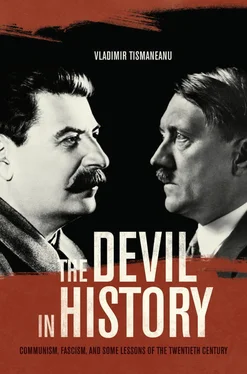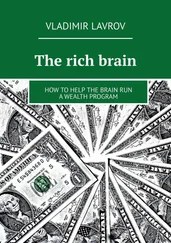In my view, clarifying these issues is enormously important for understanding the real political, moral, and cultural stakes of the post-Cold War order, an order that Ken Jowitt assumes to be “without Leninism,” but where Leninist and fundamentalist-primordialist legacies continue to haunt political memory and imagination. On the other hand, we live in a world in which not only do post-Communist specters keep resurfacing, but where post-Fascist exclusionary delusions (and their practical consequences) are not fully extinct. The war between liberalism and its revolutionary opponents (and their nostalgia) is not over, and new varieties of extreme utopian politics should not be automatically regarded as impossible.
In a famous scene in his novel La condition humaine (translated into English as Man’s Fate) , novelist André Malraux captured the great dream of twentieth-century Communism (or at least the romantic-heroic moments associated with what the French writer once called l’illusion lyrique , the lyrical illusion). The scene takes place in China, during the failed Communist insurrection of 1926. Captured by the Kuomintang, a Communist militant is asked what he finds so appealing in the cause he fights for. The answer is “because Communism defends human dignity.” “And what is dignity?” asks the tormentor. “The opposite of humiliation,” replies the true believer, shortly before his death. I know of many former Communists who joined the cause because of this extraordinary novel, which came out in the early 1930s.
For young Malraux, Communism was a story of purity and regeneration that motivated a fanatical commitment to the still promising future and a visceral opposition to the real or imagined squalor of the old, dying order. In his memoirs, Arthur Koestler described the moral attraction of early Communism, comparing it to the asceticism and martyrdom of the first Christians. But, Koestler hastened to add, in a few short decades Communism declined from the heights of moral idealism to the horrors of the Borgias and the Inquisition. Yet even so lucid a critic of totalitarianism as Raymond Aron was not ready, until the last years of his life, to admit that Communism and Nazism were equally criminal in their very systemic nature. In his influential book Démocratie et totalitarisme , based on a course he delivered in 1957-58, Aron pointed to a major distinction between the two totalitarian experiments, referring to “the idea that inspires each of the two undertakings: in one case the final result is the labor camp, whereas in the other it is the gas chamber. In one case we deal with the will to construct the new man and possibly another man by whatever means; in the other there is a literally demonic will to annihilate a pseudo-race.” Later, however, in his Memoirs , Aron renounced this distinction and wrote an unequivocal indictment of both systems as equally reprehensible: “I abhor Communism as much as I detest Nazism. The argument I once used to distinguish the class Messianism of the former from the race one advocated by the latter does not impress me anymore. The apparent universalism of Communism has become, in last analysis, a mystification.” 18This was a harsh statement that many intellectuals and social activists today are still unready to endorse. The explanation for this reluctance lies, in my view, in the enduring mythologies of anti-Fascism, including those related to the Spanish Civil War, Communist participation in the resistance movements, and a failure to admit that Nazism was not the offspring but the entranced enemy of liberal capitalism.
THE MYTH OF THE PREDESTINED PARTY
The party as the incarnation of historical rationality, with the revolutionary avant-garde elected to lead the otherwise lethargic masses into the Communist paradise, was the hallmark of the Leninist intervention in the political praxis of the twentieth century. Without the party, there would be no Bolshevik revolution and no gulag, one can say. The myth of the party, more than the myth of the leader, explains the longevity and endurance of the Leninist project. The other side, the Fascists, while invoking the commands of historical providence, invested the ultimate center of power less in the institution than in the infallible “genius” of the leader. The party mattered, but there was never the same type of institutional charismatic magnet that Leninist formations represented, particularly in the case of Nazi Germany. In the case of Fascist Italy, when the charismatic leader was deposed in 1943, the party simply could not reinvent itself despite the fact that it successfully managed to reassert its autonomy vis-à-vis the leader by way of the Fascist Grand Council. 19In Italy proper the party disintegrated, while in the Salo Republic (the part of the country under German control) Mussolini simply became a puppet in Hitler’s hands. 20Mussolini had lost the ability to perform the role of “of a modern propheta who offered his followers a new ‘mazeway’ (world-view) to redeem the nation from chaos and lead it into a new era, one that drew on a mythicized past to regenerate the future.” 21Hitler’s myth was much more resilient. Ian Kershaw remarked that his personality cult, as the nexus of “the social expectations and motivations invested in him by his followers,” 22experienced a “slow deflation rather than the swift puncture.” 23
A note should be made here regarding the possible difference between Italian Fascism and Nazism. As many scholars have already noted, in the German case the institutionalization of charisma was overshadowed by the “Führer principle.” Philippe Burrin stresses that in Nazi Germany politics were fundamentally marked by “personalized power—in the double meaning of the term, centered around the person of Hitler and founded upon direct person-to-person relationships.” In his classic study, Karl Dietrich Bracher considered that “the creation of the system of terror and extermination and the functioning of the police and SS apparatchiks operating that system rested on this overturning of all legal and moral norms by a totalitarian leader principle which did not tolerate adherence to laws, penal code, or constitution but reserved to itself complete freedom of action and decision-making. Political power was merely the executive of the Leader’s will.” 24Ian Kershaw’s fundamental analysis of the “Hitler myth” showed the leader as a political entity almost independent of the party, “the motor for integration, mobilization, and legitimation within the Nazi system of rule.” 25In this sense, the attraction of the leader principle, for the case of Germany, comes closer rather to the Lenin cult in the Soviet Union than to the cult of Stalin or Mussolini. Leaving aside its all-out religious aspects, Lenin’s cult took the form of a myth of the founding father as the infinite source of ideological rebirth and sustenance for the Communist polity. And indeed the return to “true Leninist principles” repeatedly brought relief for the Soviet regime. The perpetuation and domination of a Khrushchevite understanding of post-Stalinist Communist systems allowed for the invocation of Lenin (the leader without sin, to paraphrase Kershaw) as safeguard of the original utopia, regardless of the latter’s terrible toll on the societies that enacted it. Only the consistent failure of such ideological, cultic revivals finally showed the obsolescence of the “Lenin myth,” which ultimately crumbled under its violent legacy.
In Mussolini’s Italy, Il Duce’s myth did not represent the rationale of the Fascist religion. In Gentile’s words, “It was created out of the collective experience of a movement that considered itself invested with a missionary charisma of its own, one that was in fact not, in its beginnings, identified with Mussolini…. The Mussolini myth came into being within the environment of the Fascist religion once the latter had been institutionalized.” 26Italian Fascism enshrined the leader as an institution potentially independent of Mussolini. An Italian jurist contemporary to those times formulated the problem as follows: “If the new state is to become a permanent way of being, that is a ‘life-system,’ it cannot do without the role of the Leader because of its hierarchical structure, even if this Leader does not have the extraordinary magnitude of the Man who promoted the revolution in the first place.” 27In 1934, the Sardinian born Fascist intellectual Edgardo Sullis published a book whose title echoed Thomas á Kempis, II Duce—Imitatione de Mussolini , in which he urged the militants to pursue a political life totally dedicated to a radical transformation of society and themselves: “You should imitate Mussolini alone. You should have no other example in life except him.” 28This “totalitarian Caesarism” (to use Gentile’s term), or hierocratic Bonapartism, which allowed for the interchangeability of charisma between the leader and the party is strikingly similar to the Soviet formula of the general secretary as the “Lenin of our times” (one often used in other Communist regimes as well). In fact, the struggle between Stalin and his arch-rival Trotsky revolved around the crucial question, Who can legitimately claim to be “today’s Lenin”?
Читать дальше












